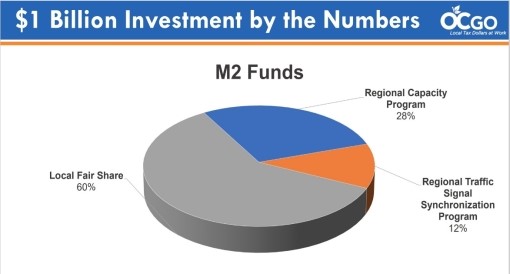Measure M, the county’s half-cent sales tax for transportation improvements, recently hit the $1 billion milestone, helping fix potholes, enhance safety and synchronize traffic signals.
ORANGE – Through Measure M, the Orange County Transportation Authority has invested more than $1 billion in Orange County streets and roads since it went into effect in 2011, helping move people more safely and efficiently throughout the county.
That major milestone was recently highlighted for the OCTA Board of Directors, which oversees how the funds are administered to local cities and jurisdictions throughout Orange County.
“The network of streets we have in Orange County is routinely noted as the best in the state and that comes only through careful planning and strong partnerships between OCTA and our cities,” said OCTA Chairman Mark A. Murphy, also the Mayor of Orange. “Ultimately, it’s the voters of Orange County who should be thanked for this significant milestone because they had the foresight to support Measure M.”
The voter-approved half-cent sales tax for transportation improvements, first approved in 1990 and renewed in 2006, is expected to generate a total of nearly $15 billion through 2041 to improve Orange County’s transportation network.
The money collected is used to continue building an efficient and sustainable transportation network, with 43% going to improve freeways, 32% going to streets, and 25% going toward public transit. Measure M also helps OCTA, the county’s transportation agency, leverage state and federal money to make improvements.
The funds that go specifically toward streets are distributed both through fair-share formula funding and through competitive grants, helping to fix potholes and resurface streets and to synchronize traffic signals in every community.

Measure M, also known as OC Go, provides money for streets through:
- The Regional Capacity Program: Provides competitive funding to improve busy streets and intersections on Orange County’s Master Plan of Arterial Highways.
- Regional Traffic Synchronization Program: Provides competitive funding to support projects across city boundaries that synchronize traffic signals to ensure drivers hit the most green lights during peak traffic hours. That includes regularly synchronizing more than 2,000 traffic lights along 750 miles of streets, which reduces congestion and improves air quality.
- Local Fair-Share Program: Provides formula-based funds to preserve existing streets and roads and provides other transportation improvements based on the priorities and needs of local agencies.
The more than $1 billion in funds invested in Orange County has helped:
- Allow Orange County to keep up with population growth and economic activities
- Lead to a more complete roadway network
- Provide safety enhancements by repairing sidewalks, upgrading pedestrian amenities with features in compliance with the American with Disabilities Act
- Add bike lanes and signage
- Relieve congestion, lessening stop-and-go traffic and benefitting the environment through green-house gas reductions
- Maintain Orange County’s standing as having the best pavement conditions in the state.
OCTA will continue investing the money collected through Measure M as Orange County’s transportation network evolves and grows.
For additional information, visit www.ocgo.com/streets.